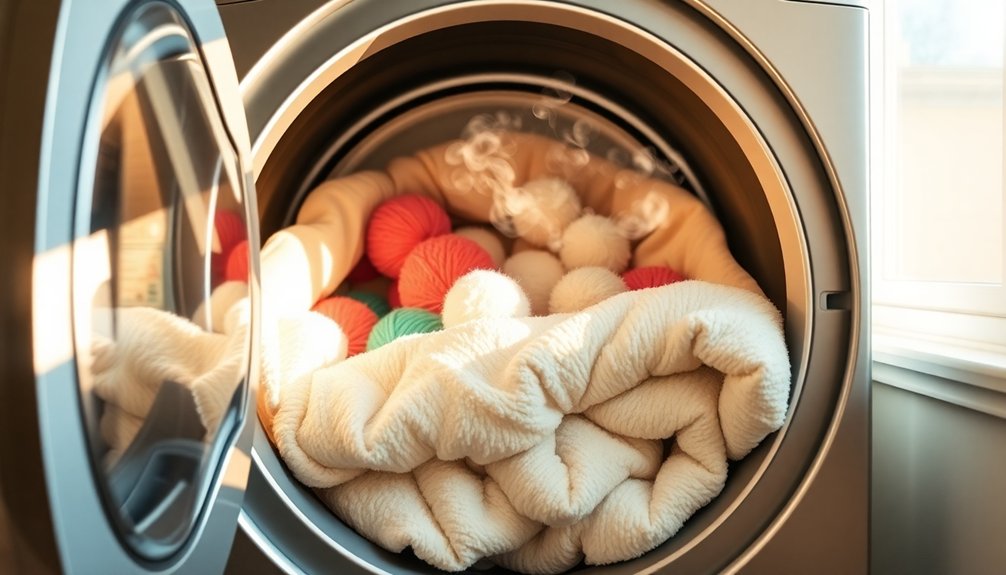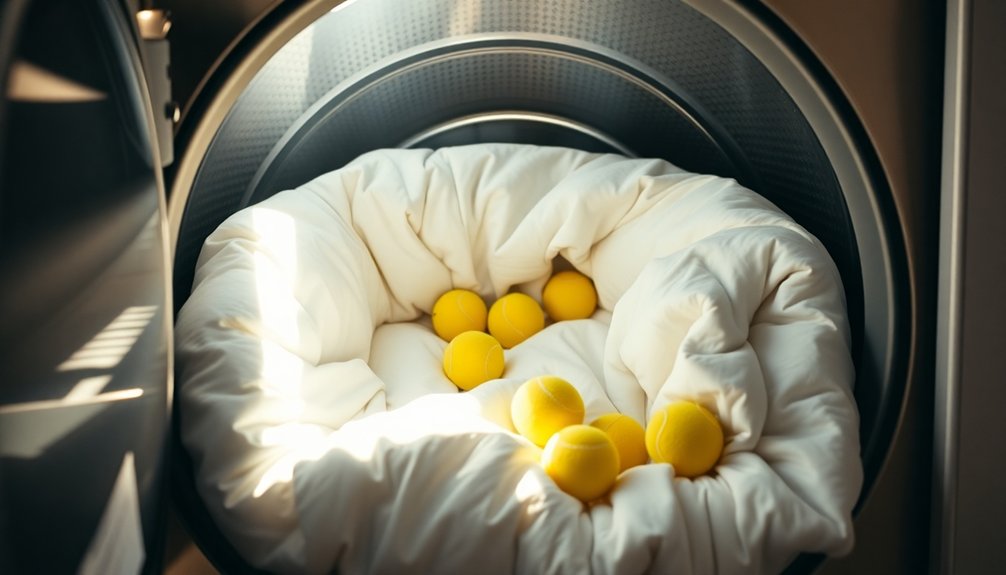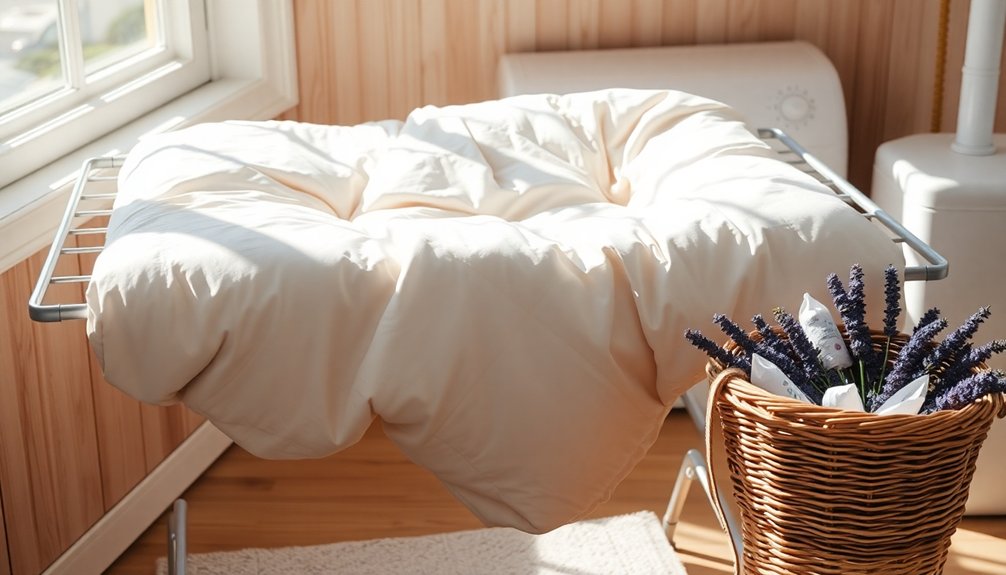To dry your comforter without clumping, start by gently squeezing out excess water after washing, avoiding any wringing. Use a large-capacity dryer on a low heat setting, adding 2-3 clean tennis balls to help fluff it as it tumbles. Pause the dryer every 20-30 minutes to manually fluff and check for damp spots. If you choose to air dry, spread it evenly on a drying rack and fluff periodically. There’s more to guarantee the best results ahead.
Preparing Your Comforter for Drying
Before you start drying your comforter, it’s essential to prepare it properly to guarantee the best results.
First, check the care label for specific drying instructions, as this will guide you on the best method.
Next, gently squeeze out excess water after washing, avoiding any wringing to protect the filling. You can also use a clean towel to help remove additional moisture, ensuring a more efficient drying process.
If the care label allows it, consider using a dryer on a low heat setting. Adding clean tennis balls can prevent clumping while drying.
Alternatively, for air drying, choose a well-ventilated area away from direct sunlight to maintain your comforter’s integrity and prevent moisture buildup. Regularly establishing cleaning routines ensures consistent hygiene and contributes to overall household well-being.
Choosing the Right Drying Method
When it comes to drying your comforter, you have two main options: using a dryer or air-drying.
Each method has its benefits and drawbacks, so it’s important to weigh them based on your comforter’s material and care instructions. Understanding these choices will help you achieve ideal results while ensuring your comforter stays in great condition. Additionally, incorporating natural cleaning solutions into your laundry routine can help maintain the freshness of your comforter.
Dryer Options Explained
Choosing the right drying method for your comforter is essential to achieving ideal results and maintaining its quality.
Use a large-capacity dryer to provide enough space for your comforter to tumble freely, preventing moisture trapping and clumping. Set the dryer to a low heat setting to protect delicate fillings and guarantee even drying without shrinkage.
Adding clean tennis balls or dryer balls can help fluff the comforter and break up clumps during the drying process. Remember to pause the dryer every 20-30 minutes to manually fluff and redistribute the filling, guaranteeing all areas dry thoroughly.
If your comforter remains damp after the initial cycle, consider air-drying it flat in a well-ventilated area to eliminate hidden moisture.
Air-Drying Benefits and Drawbacks
Air-drying a comforter can be a great alternative to using a dryer, particularly if you want to preserve the integrity of the fabric and filling. This method allows for better moisture evaporation, reducing the risk of clumping and damage.
To achieve ideal air circulation, spread your comforter evenly on a drying rack in a clean, dry area away from direct UV rays, which can cause fading. While air-drying may take up to 24 hours, it guarantees thorough drying without the unevenness of a dryer.
However, remember to periodically fluff the comforter to avoid clumping. A potential drawback is that if left damp for too long, odors or mildew may develop, so make sure your comforter stays completely dry before storage.
Using a Dryer for Optimal Results

When using a dryer, set it to low heat to give your comforter enough room to tumble freely, which helps prevent clumping.
Adding 2-3 clean tennis balls or dryer balls will further assist in fluffing the comforter and breaking up any filling clumps.
Remember to pause the dryer every 20-30 minutes to manually fluff and rearrange the comforter for even drying. Additionally, using microfiber cloths can help with any dust or debris that may accumulate on the comforter during the drying process.
Use Tennis Balls
To achieve ideal results while drying your comforter in the dryer, incorporating 2-3 clean tennis balls or dryer balls can make a significant difference. These balls help agitate the filling, ensuring even drying and preventing clumping.
Using a large-capacity dryer allows the comforter to tumble freely, reducing the risk of the filling bunching together. Remember to set your dryer on low heat; high temperatures can damage the fabric and cause clumping.
Pause the dryer every 20-30 minutes to fluff the comforter, redistributing the filling for thorough drying. Always check for damp spots before removing the comforter to avoid mold and odors, ensuring your comforter is completely dry when you finish the spin cycle.
Low Heat Setting
Setting your dryer to a low heat setting is vital for drying a comforter effectively while preserving its integrity.
Using a large capacity dryer, the low heat guarantees even drying without damaging the filling or fabric. To prevent clumping, add clean tennis balls or dryer balls; they help maintain loftiness throughout the drying process.
Remember to monitor the comforter for damp spots, as it’s important the comforter is completely dry to prevent mold and mildew growth.
Every 20–30 minutes, pause the dryer to fluff the comforter and rearrange it for consistent heat distribution.
Always refer to the care label for specific drying instructions, including temperature recommendations, to avoid damaging your comforter.
Air-Drying Techniques to Consider
Air-drying a comforter effectively requires careful attention to placement and airflow.
Start by hanging your comforter in a well-ventilated area, away from direct sunlight to prevent heat damage. Use a clothesline or drying rack to spread it out evenly, allowing air to circulate freely. This will help promote thorough drying and prevent clumping.
Periodically, shake and fluff the comforter to redistribute the filling, and if possible, rotate it every few hours. This guarantees all sections dry evenly and avoids moisture pockets.
To enhance air circulation, consider placing the comforter near a fan or in a breezy location. Following these air-drying techniques will result in a fresh, well-dried comforter without compromising its integrity. Additionally, incorporating regular decluttering into your cleaning routine can help create more space for effective drying setups.
Adding Tennis Balls for Fluffiness

When using a dryer to dry your comforter, adding tennis balls or dryer balls can greatly enhance the fluffiness and overall drying process.
These simple additions help prevent clumping by agitating the comforter, ensuring even distribution of the filling. Here’s how they work:
- Promote better airflow to reduce moisture pockets.
- Use 2-3 clean tennis balls for standard loads; larger comforters may need more.
- Consider dryer balls made of wool for gentler care on delicate fabrics.
- Periodically pause the dryer every 20-30 minutes to manually fluff the comforter and check for damp spots.
- Additionally, implementing efficient home maintenance tips can help you keep your comforters and other linens in great condition over time.
Fluffing Your Comforter During Drying
To guarantee your comforter dries evenly and maintains its fluffiness, regularly fluffing it during the drying process is essential.
Regularly fluffing your comforter while it dries is key to ensuring even drying and lasting fluffiness.
If you’re using a dryer, set it to a low heat setting and add clean tennis balls or dryer balls to help break up any lumps. Every 20–30 minutes, pause the dryer to manually fluff the comforter and redistribute the filling, ensuring all areas get heat for thoroughly drying.
If you’re air-drying, hang your comforter in a well-ventilated area and periodically shake and fluff it to prevent clumping. Regularly fluffing your comforter can also help reduce the spread of harmful bacteria that may accumulate in damp fabrics.
For larger comforters, consider a commercial dryer, but remember to fluff it regularly to maintain its shape and comfort throughout the drying process.
Post-Drying Care for Your Comforter

Once you’ve successfully dried your comforter, it’s crucial to give it some post-drying care to guarantee it stays in top condition.
Follow these steps to maintain its quality:
- Fluff the comforter by hand to restore loftiness and ensure even distribution of filling, preventing clumping.
- Inspect for damp spots; if found, return it to the dryer on low heat until completely dry to avoid mold and mildew.
- Hang it outside on a sunny day to air out and eliminate any musty odors.
- Store it in a breathable cotton bag to prevent moisture buildup and check periodically for any signs of dampness or clumping. Regularly changing your bed linens can help reduce allergens such as dust mites that may affect your comforter.
Storing Your Comforter Properly
Properly storing your comforter can greatly extend its lifespan and maintain its fluffiness. Before you store the comforter, make sure it’s completely clean and dry to prevent mold and mildew.
Use breathable cotton storage bags to protect your comforter while allowing for air circulation; avoid plastic bags that trap moisture. Store the comforter in a cool, dry environment to keep it fresh and prevent musty odors. Additionally, incorporate eco-friendly materials in your storage solutions to enhance sustainability and protect your bedding. Regularly check for signs of moisture or dampness, addressing any issues early to maintain its fluffiness. Additionally, air out the comforter every few months during storage to help it stay fresh and odor-free.
Following these steps will guarantee your comforter remains in excellent condition for many cozy nights ahead.
Conclusion
In summary, drying your comforter doesn’t have to be an intimidating disaster. By following these straightforward steps, you’ll achieve a fluffy, fresh finish. Whether you choose the gentle warmth of a dryer or the natural breeze of air-drying, remember to fluff and fold with care. Your cozy companion will be ready to wrap you in warmth, ensuring serene slumbers. So, savor the satisfaction of a wonderfully well-dried comforter, and sleep soundly in its soft embrace!